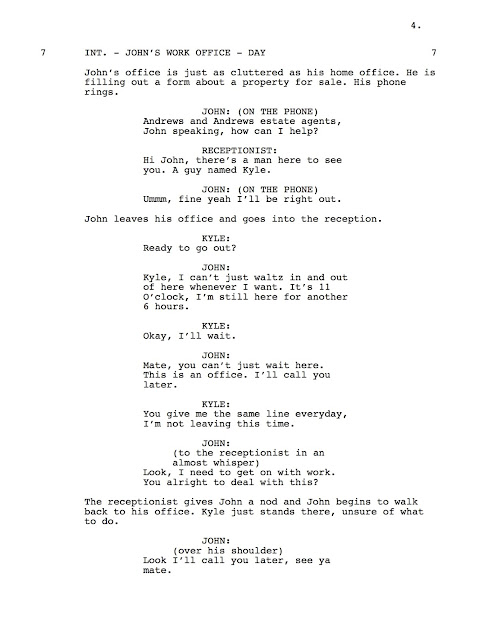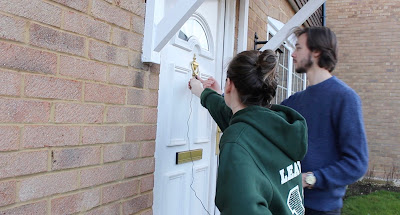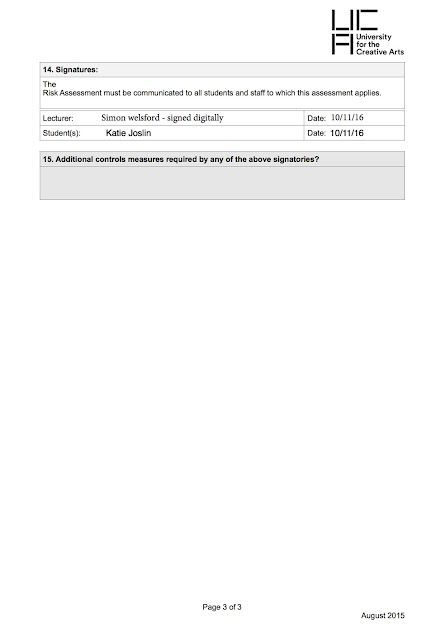The Production Process
When the brief was first introduced to us, I found the whole thing quite daunting. I had no idea how I was even going to come up with an idea, let alone a 10 page screenplay, a 2 minute trailer and a whole load of research around the topic of screenwriting. The story-telling workshops were extremely helpful in terms of producing ideas. I ended up finding my idea from a
newspaper article about a man searching for the person who talked him down from a suicide attempt. Obviously I couldn't just copy this story, so I decided to take inspiration from it and develop a story of my own. My
initial ideas and
developed ideas for my story can be found on my blog.
Once I had my idea, I then had to go about creating a 25 word pitch. 25 words seemed way to little for conveying the whole idea for a story, but after the story-telling workshops I found it a lot easier trying to convey the idea for my story concisely. The next thing for me to do was to create my characters. I already had a couple of characters in mind. I decided my character John would be the main character of my story. He would be a young, 24 year old man with a beard and slightly 'scruffy' clothes. My other character (Kyle) would be almost the opposite of John, a clean shaved, sharply dressed 22 year old man. I wanted the two characters to be opposites as I wanted Kyle to represent what John aspires to be. My
25 word pitch and character ideas can be found on my blog.
The next thing to do was to start the script. This is where I ran into some difficulty. I kept writing a page or 2 and then becoming completely stuck. I decided I needed to talk to Simon about it and ask him why I seemed to be getting nowhere with my script. The feedback I received was that I didn't know my characters well enough, I didn't know their past and I didn't know what they wanted to achieve. Following this feedback, I decided to completely work out my characters (even if some things would not be used in the story). Once I had discovered who my characters were and what their personal goals were, it became a lot more straight forward writing the script.
I then received some feedback from Steve about my script. I needed to add more structure to the script by adding more scenes, I needed to make some parts of the script less clumsy and I needed to work on some scenes with interaction between my characters. All the feedback really helped me to make my script stronger. When I gave in my first draft of my script, I had doubts as to whether it was any good at all, therefore, the feedback really helped as it showed I had the bones of a good story but just needed to work on a few bits to make the screenplay work as a whole. For my second draft, I decided to implement all of Steve's advice and see what this did to my script. Unfortunately, with all of his advice, my screenplay became too long. Therefore I had to cut out some of the original material and a small section that Steve advised I included - this became my third draft. I still wasn't entirely happy with my script as I had left out a vital moment that Steve thought would work really well in my script. I therefore went about cutting small irrelevant parts out of my script (that, looking back on it, really didn't need to be there in the first place) in order to fit in the scene in the doctor's office. My
first,
second,
third and
final draft can be found on my blog.
I actually decided to shoot my trailer before completely correcting my script. But before I could start filming, there were multiple things I had to sort out before the shoot. I had to find my
actors and locations,
fill out risk assessments, apply for film permits and come up with a
shot list and shooting schedule. The shot list and shooting schedule really enabled my shoot to be quick and efficient as all the actors knew where they had to be, what they had to be doing and when. I did encounter some problems in filming, but all of these issues were easily resolved. A detailed account of how my shoot went can be found
here.
After my shoot was over, I decided to get straight on with creating a rough cut for my trailer. I imported the footage and roughly cut it together into a sequence. I then showed this rough cut to Simon and Mike who both gave me their individual feedback. I agreed with all their feedback and began implementing it straight away. Once I had applied all their feedback and tweaked a few extra things I came up with a fine cut for my piece. It still wasn't perfect but it was a lot closer to being finished. The only things left to do were add a production logo and adjust the titles. Once this was done I had my final trailer. The
rough cut,
fine cut and
final trailer can all be found on my blog.
What worked?
- The idea worked really well when coming to write the script. Although I did hit a few hurdles initially, once I had worked out who my characters were in detail, writing the script became a lot more simple.
- My organisation before the shoot was very good. My detailed shot list combined with my shooting schedule ensured that all actors knew where and when they were needed and what they were doing. I also had good contact with both the actors and we were able to constantly correspond to make sure the filming days still suited everyone's personal schedules. I also sorted out the film permits a couple of weeks before my shoot which allowed time for if there were any difficulties. This good organisation lead to a very efficient shoot day (I ended up only needed one out of my two days).
- I think the editing of my trailer works really well. I especially think the overlapped footage works well to convey the sense of confusion that my character is feeling. The fades to black follow the conventions of a normal film trailer, they work really well in my trailer because they help to build tension whilst also maintaining a sense of mystery and enigma.
- The previous editing workshops really came in handy when it came to edit my final trailer. I knew exactly what I was doing from the moment I started editing.
- I think the location of the pier worked really well and I was very fortunate with the weather. It was quite windy making the water look more dramatic. This helps add to the mood and tone of the trailer.
- The acting of my actors worked really well. Jason was able to convey a confused / distracted / panicked look very accurately -this enabled the audience to easily understand my character's emotion. Alex was excellent at portraying a believable character. His acting looked natural which helps to audience to feel at ease with the trailer.
What didn't work?
- I think the sound in my trailer could have been recorded slightly better. Due to difficulty getting to the studios to pick up the equipment, I ended up using my own camera equipment. However, my microphone was not as good quality as the microphones used in the studios meaning that I did experience a couple of sound issues. Although the majority of these sound issues could be fixed in post production, I feel like the editing affected the quality of the sounds. Therefore, in future I will use the studio's equipment.
- There was one bit of my footage which I really wish I filmed differently. When my character John is looking out over the pier, it may not be clear that his intention is to jump - leading to a bit of confusion when Kyle says "John, don't". Mike Rymer suggested I could use a 'trick shot' and get my character John to step up on a box (not seen in shot) to make it look like he is climbing the railings. However, I didn't have time to re-film so had to make do with the footage I had. To try and convey his desire to jump over the edge, I decided to use a POV shot of the camera changing angle to look down into the water.
- I actually ended up getting so much footage that some parts that I really liked had to be left out. In future I could add timings to be shot list so that I know roughly how much time each clip will take up in the trailer so that I don't end up having to cut out material that I really like. Having said that, I'm glad I got more coverage than I needed as I was able to use shots that I wasn't initially planning to use.
- I feel like my script could have been stronger. Even after implementing Steve's advice, I'm still not completely happy with my script. I feel that one of my big 'moments' (John going to jump off the pier) is resolved too quickly, yet I didn't know how to make the moment last longer without it becoming repetitive or boring.
- Although I did a lot of research into screenwriting, screenwriters, short films and TV dramas, I feel like I should have done more into mental health, especially schizophrenia. I found it hard to write the character in a believable way knowing only a few facts about schizophrenia which I learnt from A-level Psychology and from the newspaper article I used as source material.
What did I learn?
- Sound is very important to a piece of footage. Poor quality sound really does affect the quality of the whole trailer. Luckily, I was able to resolve my sound issues, however, it would have been better to use a proper rode directional microphone with a wind protector / dead wombat in order to get better quality sound.
- I learnt a lot about directing. I had to direct my actors and tell them exactly what I wanted to do. My direction was good as my actors performed exactly how I wanted them to. I had no experience about directing before the project, so I definitely learnt a lot about the role.
What could I develop?
- In future I will do more research into the actual content of my project rather than just research around the project. I will look for real life accounts from people in order to make my stories more realistic and to be able to work out how my characters would really react to certain situations.
- I will get my script checked more in order to make the screenplay stronger. I only obatined initial feedback from Simon and then another lot of feedback from Steve once my first draft was completed. In future, I will get the second and third drafts checked as well instead of relying on my own judgement. This will make my screenplay stronger and therefore my story telling and final trailer would also be stronger as a result.
Conclusion:
Overall I am very happy with how this project went, especially since it is my first project on the course. I think my trailer really captures a sense of my story well even with the weaknesses in my script.







































